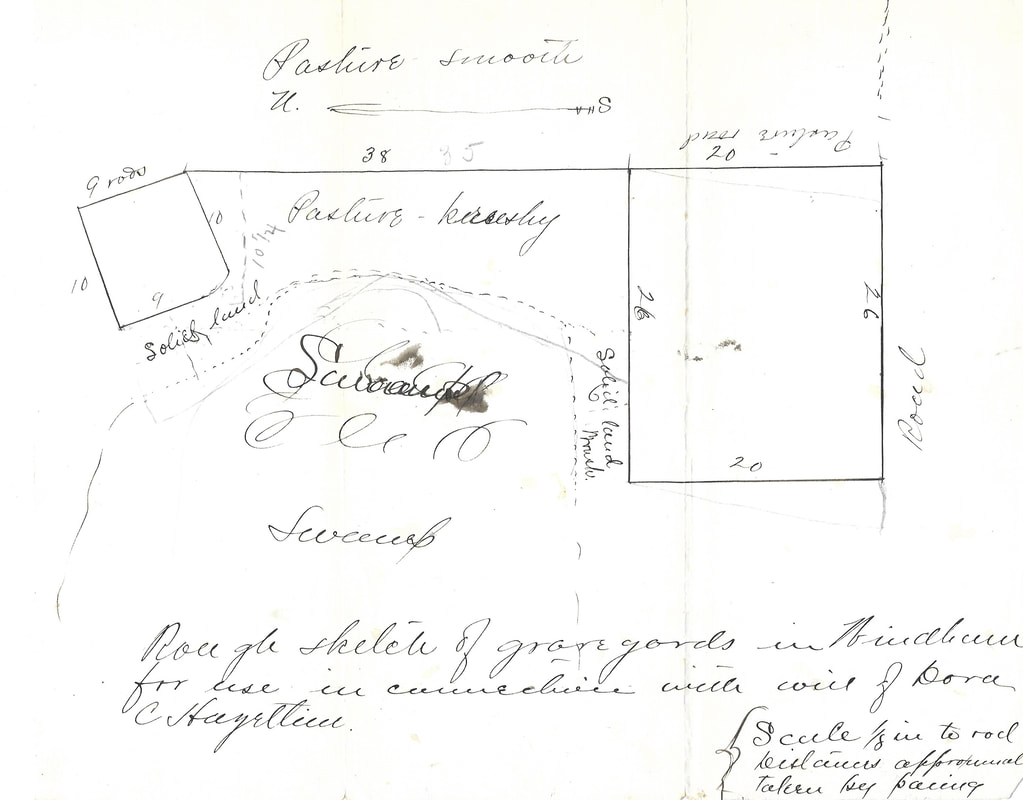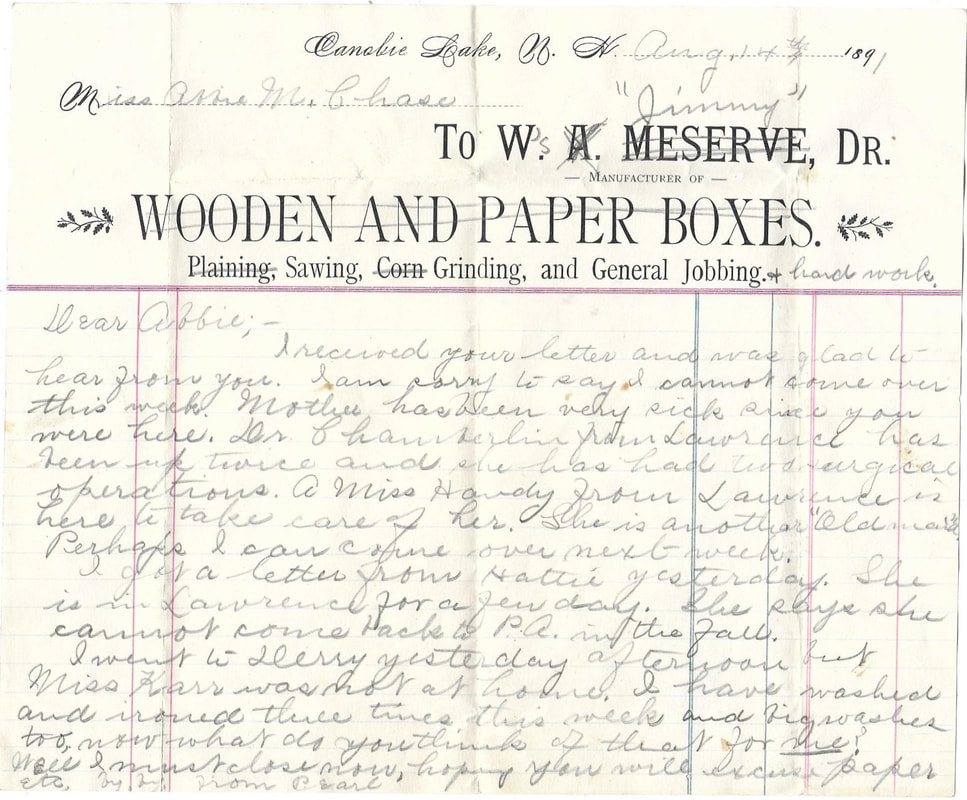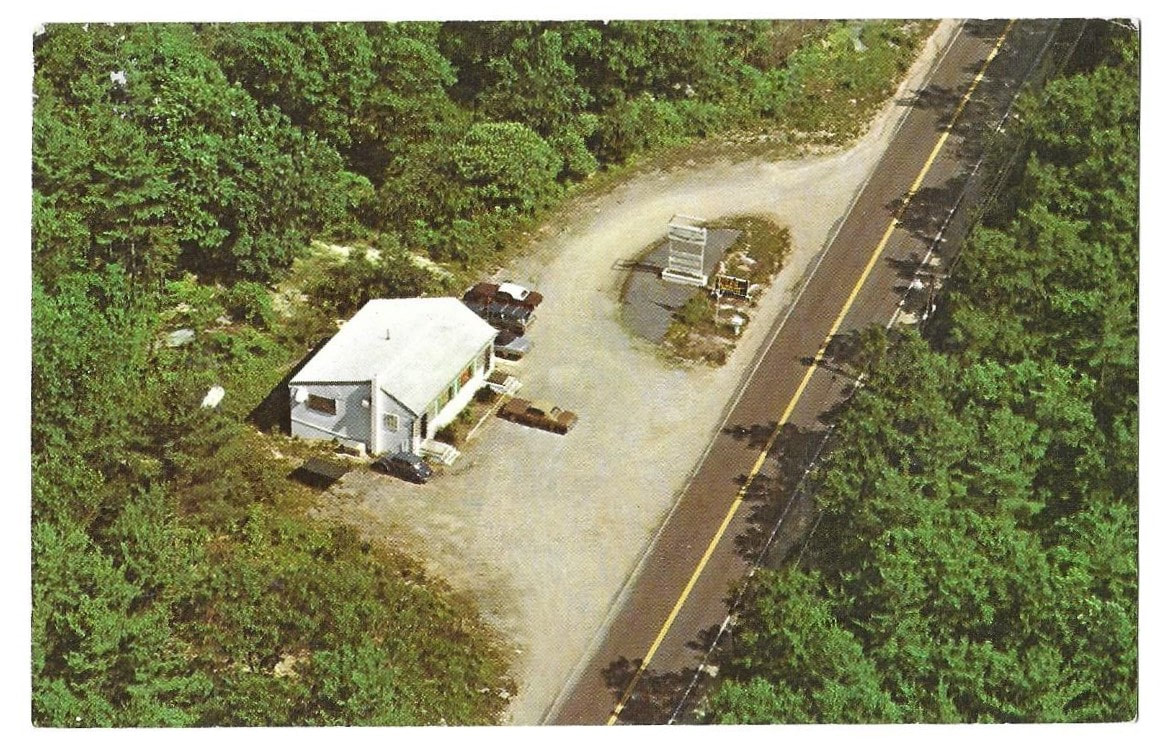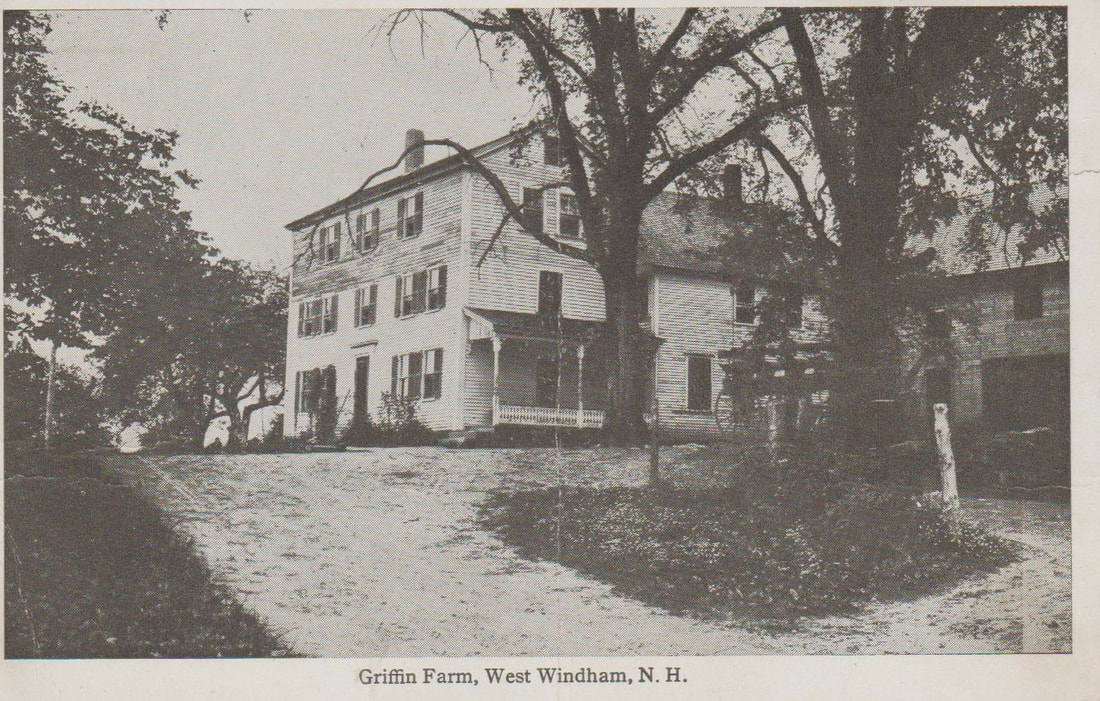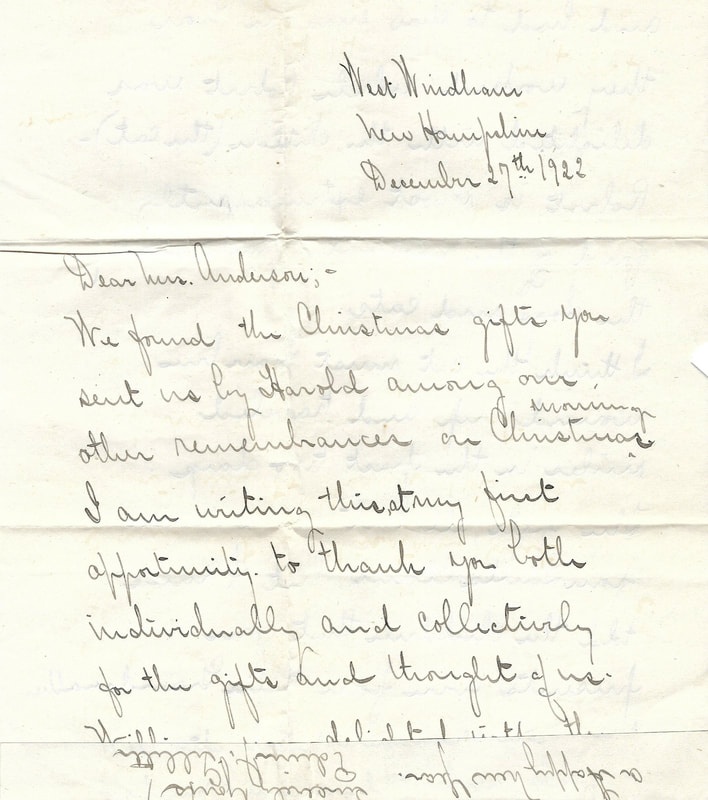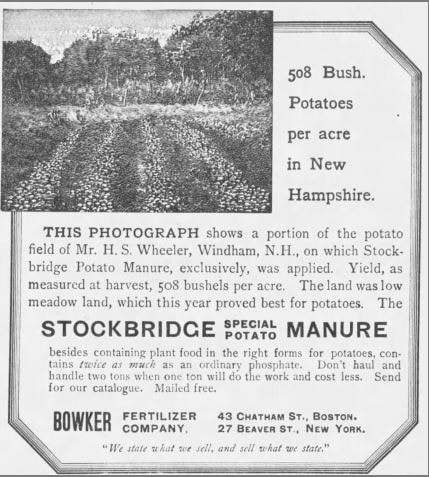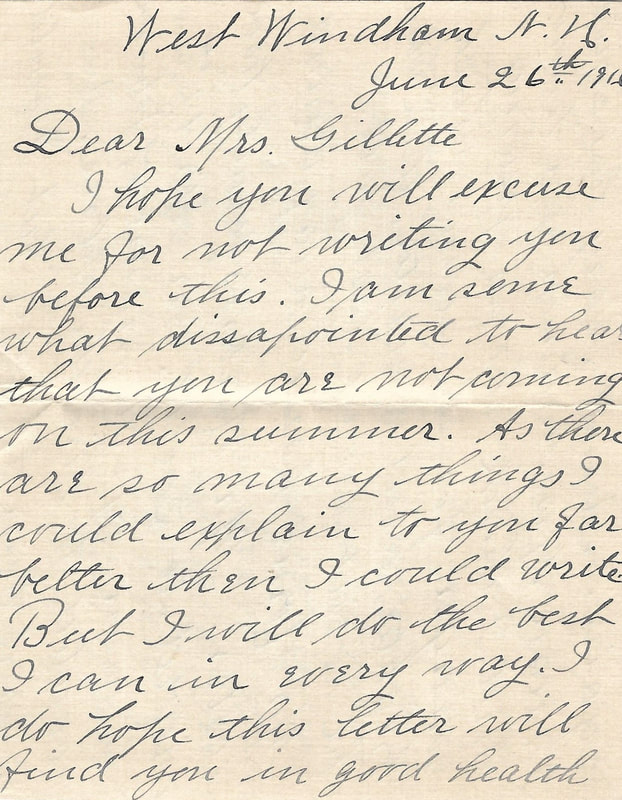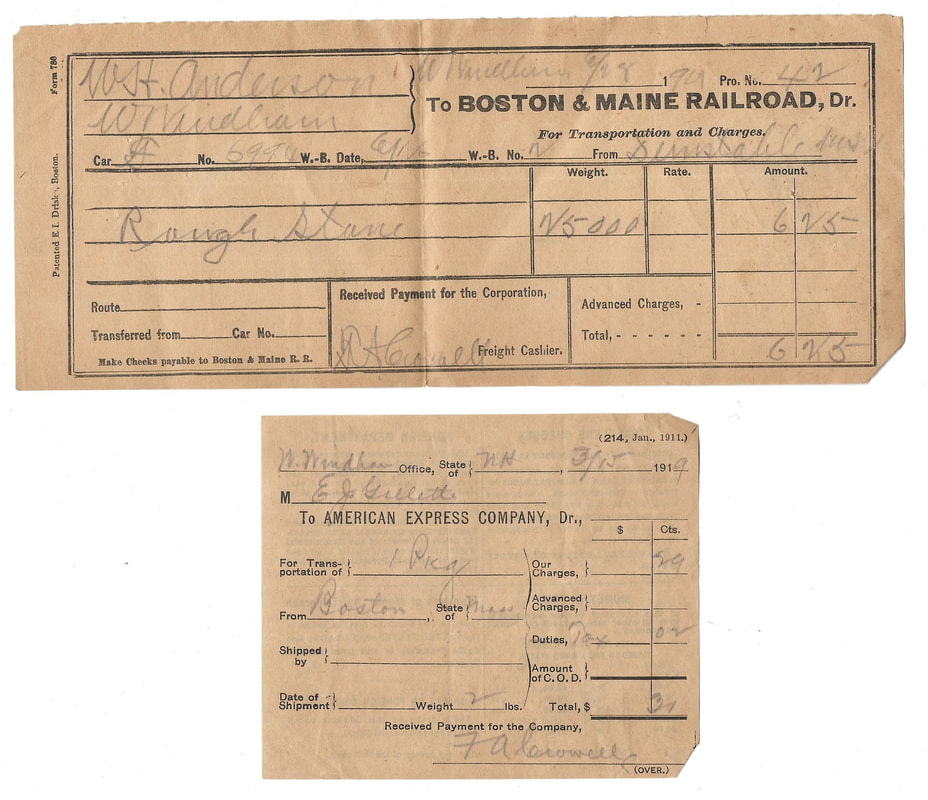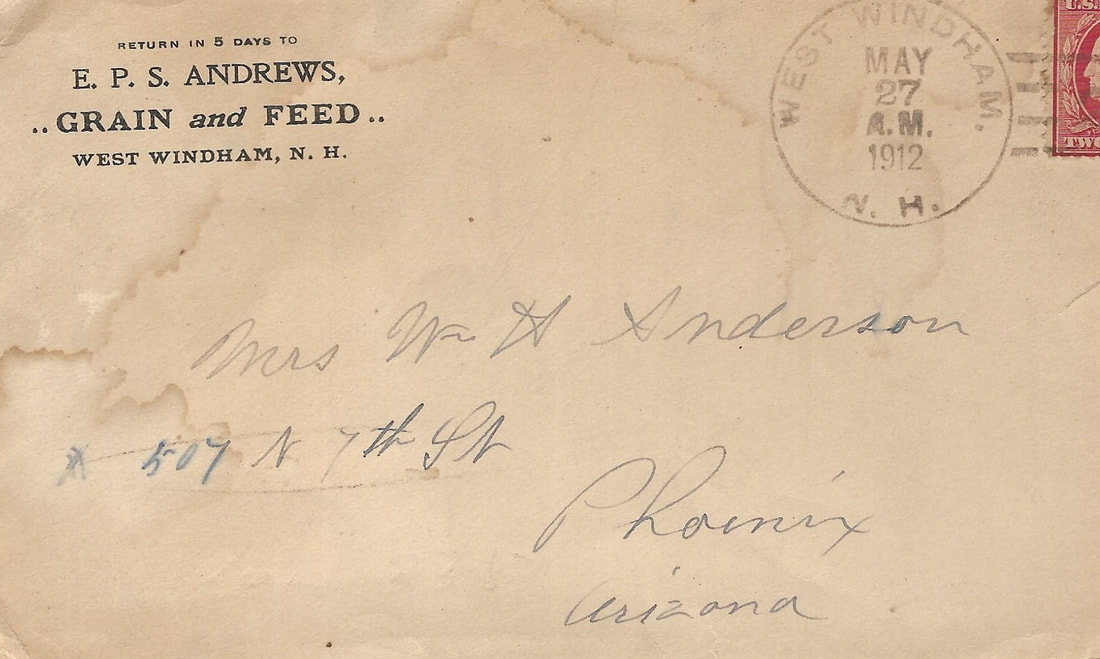|
The plan shown above was drawn in the mid-1860s upon the death of Dora C. Hazeltine. The person who drew up the plan did not sign his name, but he did leave behind an interesting not that the distances were calculated by pacing them out, and that it was drawn in a 1/8" to one rod scale. At the time this view was drawn up the newer section in the middle of the two graveyards had not yet been used as a cemetery and was indicated as "pasture". The plan shows what is now Cobbetts Pond Road on the right, and the swamp in the back. What is now Ministerial Road, is referred to only as "pasture road", with a large open pasture on the opposite side.
0 Comments
While Henry Ford was busy building his first car, the Quadricycle, in 1896, twenty-five year-old William Forest Meserve of Windham was perfecting his first automobile, nicknamed the “Devil Wagon.” Meserve’s steam-powered vehicle first took to the streets that year, certainly garnering the attention and surprise of his neighbors who had likely never seen such a machine before. According to Derry, New Hampshire historian Rick Holmes, the “Devil Wagon” was a wagon outfitted with a two cylinder steam motorboat engine. When he was not able to procure commercially available automotive tires for his vehicle, Meserve convinced a manufacturer of bicycle tires to build him a custom set of three inch pneumatic tires. When Meserve drove the wagon to the 1899 commencement exercises at Pinkerton Academy, the local newspaper reported that it was the first automobile to be seen in the area. Although the car would have been relatively primitive compared with turn-of-the-century production automobiles, a Derry grocer purchased the original “Devil Wagon” as a delivery vehicle.
Born in 1871, William Forest Meserve moved to Windham with his father by the 1880s; they had been living in Wakefield, New Hampshire. His father had purchased John Brown’s mill in East Windham, which had been built in 1887. In 1888, the elder Meserve became ill, and young Will dropped out of school to run the mill. It was under his management that the mill became the first building in town to use electric lighting. This electric marvel was accomplished simply by reading a how-to book he had purchased at the Mechanic’s Fair in Boston a couple of years prior. Not only did his generator provide electric light to the mill, but to his home across the street. By 1893, according to Leonard Morrison, the mill was “a well-equipped saw and grist, cider, and planing mill, and box factory. The Meserve family resided in a newly built house across from the mill, which was completed in 1892. With a new house and successful mill, Will Meserve was positioned well to provide for his new wife and three children; Will had married Abbie Chase of Derry in 1893. Just a few years later, Meserve entered the automobile business. First was the “Devil Wagon”, but next he built an electric car, and shortly after his first gasoline powered automobile. Like his first car, he bought a used boat engine, except this time a gasoline powered one, and built a transmission for it. He used a Concord Carriage as the chassis, but designed the rear end himself. In 1901, Meserve used his mechanical skills to manufacture a delivery truck for the Pemberton Mills in Lawrence, Massachusetts; the truck remained in use until 1924. In 1902, Meserve founded Windham’s first, and only, automobile manufacturing company, the Meserve Auto Truck Company. While Meserve built several more custom order automobiles after 1902, it is not known whether the Meserve Auto Truck Company ever manufactured an automobile. In 1903, the Meserve family moved to Derry, where William ran his own business, worked for H.P. Hood and busied himself with side jobs, like assembling Derry’s new mail order jail cells. Judge Bartlett of Derry ordered a custom car from Meserve in 1904; the finished automobile was thirteen feet long, one-and-a-half tons, and 50 horsepower. According to legend, Meserve was sickened by carbon monoxide fumes while building Judge Barlett’s vehicle, and was too ill to accept a position as head engineer with Packard. In 1911, the family moved to Salem, where William opened an automobile repair shop. William Forest Meserve passed away in 1933. This article is compiled with information from several sources: “Supplement to the History of Windham in New Hampshire” “Rural Oasis: History of Windham, New Hampshire” Hillside 28 Restaurant and Lounge opened on Route 28 in Windham on May 6, 1975. Jennie and Charlie Kusker, the owners of the restaurant, served their homemade Italian meals from 11AM to Midnight on every day except Monday. According to a period advertisement, all food served at Hillside 28 was cooked fresh by Chef Giovannina (Jennie Kusker) with her famous home made Italian sauce. Known for their "special HEROES" ("a meal in every sandwich"), they also served a variety of beer, wine, and "fine cocktails". When the Bicentennial arrived in 1976, the restaurant's menu and advertising got a makeover in the "Spirit of 1776". That year they offered a complete dinner for four people for just $17.76. This dinner included a choice of four entrees: veal or eggplant parmesan; the "seafood special"; baked stuffed clams, shrimp, and shells en casserole; and baked lasagna. The chosen entree was complemented with soup, salad, dessert, and coffee. With a knack for advertising, this was not the only special offered by the Kuskers. Every Sunday children under 12 ate at the restaurant for free; children received a free "Snoopy cocktail" throughout the week; every Wednesday the Hillside offered a two-for-one special advertised to be "within your means." The Hillside 28 Restaurant and Lounge remained open for several years, at least until 1979.
According to LondonderryNH.net, Griffin Farm was located near the Londonderry and West Windham line, on Breakneck Hill (now Griffin Avenue). Frank Griffin and his wife Margaret bought the farm in 1898 and added the third story to accommodate their ten children. By the 1940s, the farm produced enough native green peas to support a wholesale and retail business in the crop. Evidently adequate farm help could not be found in West Windham, as the farm's owner would advertise in the Nashua Telegraph looking for pea pickers. On Friday mornings, a truck would leave Griffin Farm for Nashua, arriving at the Soldiers and Sailors monument around 8AM. The truck would transport anyone looking for a days work picking peas back to the farm and later back to Nashua. With the peas picked every Friday, Griffin Farm would take orders by telephone for deliveries to be made in the Nashua area each Saturday.
At the turn of the twentieth century, the Boston Globe was one of the more popular newspapers available in Windham, along with The Derry News and the Exeter News-letter. Editions of the Boston Globe during that period often contained classified ads placed by Windham residents, including the ever-popular ads for summer boarding houses. A more unusual ad was placed in 1916 by the holder of Address Box 1002. The very brief ad read "Wanted - A nice, clean lady, not over 40 years old, as housekeeper in country..." In addition to meeting the cleanliness and age requirements, a qualified housekeeper must not have had children. The ideal candidate would be "your own boss" and receive $3 per week; according to the US Census, the average wages would have amounted to about $13 per week at that time.
Dr. Edwin Gillette and his family lived for several years in West Windham. Close friends of the Andersons, the two families were frequently in contact. In 1922, Mrs. Anderson sent gifts to the Gillette children for Christmas. Dr. Gillette wrote Mrs. Anderson just a couple of days after Christmas to thank Mrs. Anderson for her thoughtfulness in sending the presents. According to his letter, William Gillette "was delighted with the clucking hens and barking dog," so much so that he "had to show every one how they worked"; these were presumably windup toys. Robert Gillette received a windup cat, and evidently loved it as his father wrote: "I think the cat must have been wound up and traveled miles in the past two days." Dr. Gillette concluded his letter with informing Mrs. Anderson that "the gifts, all but yours came from Santa Claus, but I have told the children that your presents were from their Grandmother."
In 1893 the average American potato farmer produced just over 78 bushels of potatoes per acre, according to research compiled by the Federal Reserve Bank of St. Louis. That same year, with help from some specially formulated manure, one local farmer was able to crush that average with a yield of 508 bushels per acre. Henry S. Wheeler was a farmer on the Windham/Derry line, on what was known as the "Fitz Farm". Wheeler lived on the farm with his wife, Hannah, a Derry native he married in 1877, along with their five children: Caroline, Sarah, Mary, Elizabeth, and Henrietta. With a family of seven to feed, Wheeler undoubtedly needed any advantage he could find in ensuring a successful harvest each year. In 1893 Wheeler tried Stockbridge Special Potato Manure, which resulted in a fantastic harvest of over 500 bushels of potatoes per acre. According to an ad for the product, it contained "plant food in the right forms for potatoes" in quantities "twice as much as an ordinary phosphate". With double the amount of ingredients as competing manures, Stockbridge was advertised as a time saving and money saving alternative to their competitors: "Don't haul and handle two tons when one ton will do the work and cost less." Such a proposition was undoubtedly attractive to Wheeler who was so successful with the product that the company took a photograph of his farm to use in their advertising.
Mrs. Edwin Gillette owned property on the West Windham / Londonderry line, in an area that was considered to be a portion of West Windham in the early 20th century. The Gillette family also owned a home in Arizona and would often summer at their West Windham home. When they were away from Windham, the property would be looked after by Thomas Waterhouse who worked for the family in this capacity. For a now unknown reason, Mrs. Gillette did not make the trip to West Windham during the summer of 1916, leaving Waterhouse to write her to inform her of the goings on in the community. In June of that year he wrote her that Mrs. Horne had passed away around Easter, and the Herberts, another West Windham family, had moved to Lowell. Evidently, the Gillettes would rent out their property as Waterhouse informed Mrs. Gillette that "a man by the name of Johnson wanted to hire the place. I referred him to you, but I would say no, as I do not think you want any more, thank you people over there."
Thomas Waterhouse had been responsible for taking care of the farming on the Gillette property and also wrote that he had "plowed up some of the land for corn and am doing the best I can with every thing." He gladly reported that "all the stock are well and in good condition." However, there had been little time for farming as Waterhouse had been busy with other work, including mowing lawns in Lowell twice a week. Anderson Station in West Windham offered convenient freight shipping for the many businesses in that part of town. Not only did the Boston & Maine Railroad make use of the station, there was also an American Express agent. Long before becoming the credit card brand they are known as today, the company was a leading freight shipper. During the 1910s and 1920s, Frank A. Crowell was both the American Express agent and the freight cashier for the Boston & Maine Railroad at the West Windham station. Crowell was a resident of West Windham, and at one timed owned a single share in the Union Hall. Crowell undoubtedly had a busy job handling shipping for his neighbors and, according to the receipts shown above, was on the job from at least 1919 to 1928. According to "Rural Oasis", around 1910 the West Windham station "contributed more than a hundred carloads of wood and lumber a month during the winter season." In 1928, William Henry Anderson paid a total of $6.25 for a load of rough stone sent from to Dunstable to West Windham. However, not all shipping done at West Windham station was by the carload. In 1919, Edwin Gillette received a 2lb package from Boston that had been shipped by the American Express Company for just 31 cents including tax
Edward P. S. Andrews moved to West Windham from Arizona at the turn of the twentieth century. His trip to Windham was arranged by William H. Anderson, who was residing in Phoenix at the time. Anderson owned a large farm in Londonderry, as well as property in Windham. His Windham real estate included the mill at Beaver Brook, which he had just rebuilt following a fire; the mill had burned twice within a decade. To oversee the management of his grain mill, Anderson hired Andrews, who would spend the next decade overseeing the production of grain and feed at the West Windham mill. In 1905 the state Cattle Commissioners recorded a visit to West Windham for a "cattle and stable" inspection on the property of Andrews.
Not content with spending his days running a grain mill, Andrews turned to inventing, eventually filing a patent for a "Torpedo placer"; a "torpedo" was a detonating signal device, the size of a typical coin, that was placed on railroad tracks. According to Wikipedia, common uses for these torpedoes include: a warning/stop signal during heavy fog (when signals were difficult to see), to indicate a train is stopped on the tracks ahead, and to alert railroad workers if a train was approaching. Andrews' device was designed to place "detonating signals upon the tracks when while trains are in motion." His invention was "simple in construction and inexpensive to manufacture, which can easily be removably attached to a car for the placing of detonating signals upon the tracks." Just six months after filing his patent in the summer of 1908, the patent was granted by the US Patent Office. Although the residents of West Windham likely recognized him as an inventor and operator of the local grain mill, he was most noted for his automobile, the first of its kind in West Windham. This car was memorable enough to be recorded in "Rural Oasis", where it is noted that the automobile was assembled from at least two early cars. While it may not have been a purebred, his car was registered in 1912 as a Ford, with a 14.5 horsepower engine. For comparison, a stock Ford Model T from the era would have left the factory with 20 horsepower, and Joseph Dinsmoor registered his powerful 25.6 horsepower E-M-F automobile the same year. Andrews received registration number 1753, with several thousand cars being registered in New Hampshire that year. Unwilling to leave his prized Ford exposed to the weather, Andrews made his own cement blocks and built a garage; this garage was likely the first automobile garage in Windham. |
AuthorDerek Saffie is an avid Windham historian who enjoys researching and sharing his collection with all those interested in the history of the New England town. Archives
November 2019
Categories
All
|
